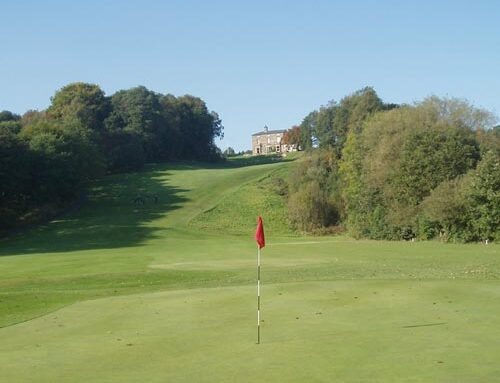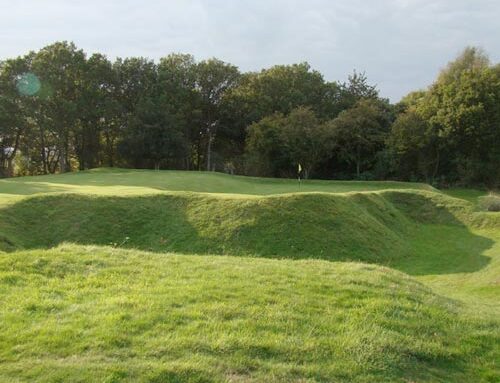Notts Golf Club
Nottinghamshire, England
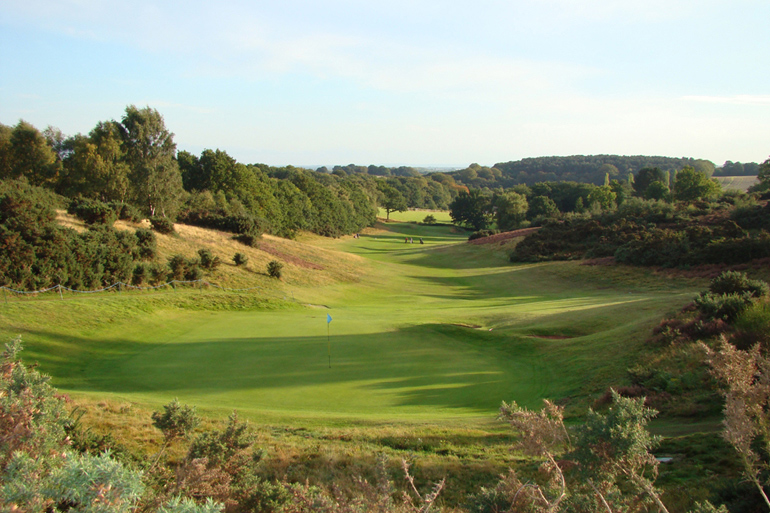
Tucked away fourteen miles from Nottingham, Notts has no peer for inland golf in the United Kingdom as it fully realizes the glories of golf in the English countryside. Pictured above is a view back down the eleventh fairway.
The year 1901 was surely a grand one for Willie Park Junior in that three of his most heralded courses opened: The Old Course at Sunningdale, his beloved Huntercombe and in November, the Hollinwell course in Nottinghamshire. Few architects have three such outstanding courses to their entire resume, let alone the same year! Famous for his untiring work ethic, Park may have worked himself to death, at least according to some historians. Regardless, these three designs at the start of the twentieth century established Park as the preeminent golf course architect for what would become known as the Golden Age of Golf Course Architecture.
Park’s great strength was his ability to route a course and to use the ground contours to maximum effect. He didn’t believe in the prolific use of man-made hazards (i.e. bunkers) and others bunkered his work. In the case of Notts, J.H. Taylor was called in the following year and much of Notts existing bunkering schemes are his work. (Later, Taylor returned the favor to Park: When Taylor was awarded the contract to build Aldeburgh in Suffolk, he commissioned Park to route the course which Taylor then bunkered).
In 1912, the final significant piece of the puzzle fell into place when Tom Williamson, the golf professional at Notts from 1896 til his death in 1950 (!), built three new holes on the west side of the entrance drive. These holes (today’s first through third) replaced several hilly holes past today’s thirteenth tee and to the left of the ninth green. Thanks to Williamson, the final eighteen playing corridors were now in place. By 1934, the course measured 6,720 yards and by 1981, it measured over 7,000, a sure sign of the club’s long standing intent to host big events. Today, it measures 7,250 yards and is capable of hosting any event it wishes. In 2012, it will host the Boy’s Championships and it is one of the few Golden Age courses that can handle the prodigious distances that the fellows now hit it.
As the course is located near Nottingham, the visitor cannot help but conjure up images of Robin Hood’s Sherwood Forest. However, Notts does not play through a forest but features markedly varied terrain which was extremely well utilized by Park and Williamson. It has holes that are heathland in character (e.g., the fourth and fifth), holes of a wooded nature (e.g., the seventh and eighth) and holes that attack the hills (e.g., the twelfth, thirteenth and fifteenth). Despite these different ‘looks,’ the course holds together well as one entity and not several different fragments.
One charming aspect of Notts is that the course is home to several different species of gorse, one of which is always in bloom, adding a fine touch of color to the landscape. For those who always seem to miss Dornoch or County Down at the ‘right’ time of year, you can appreciate how nice this feature is.
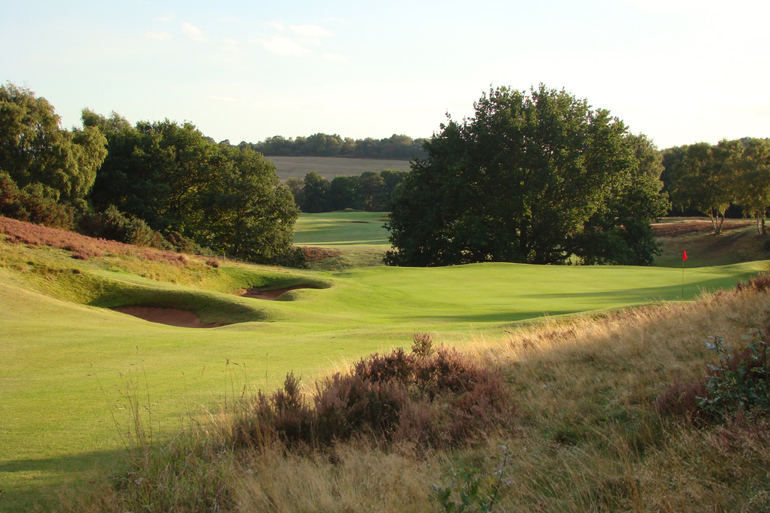
The combination of its hardwoods, grass schemes, ferns, heather and gorse endows Notts great texture and makes it visually arresting.
Another interesting aspect is the presentation of its bunkers which predominately feature grass rolled down at least half the bunker face. The ninth is an instructive hole relative to the presentation of its bunkers. Unlike Ganton and Woodhall Spa, the bunkers do not dominate the player’s perception of the course. The grass faced bunkers, though invariably well placed, don’t confront the golfer with a sea of sand. Rather, the golfer is left to admire the magnificent property.

The setting for the ninth green is postcard perfect and the bunkers certainly don’t dominate the view from the tee. Yet …

… closer inspection shows the true scale of the fronting bunker.
Holes to Note
Second hole, 460 yards; After a mild opening, the course quickly establishes its muscle. This attractive, uphill dogleg left finishes with its green in front of the rock known as ‘Robin Hood’s Chair’ in a cleft between two large, pine-covered hills. Drive to the outside of the dogleg and the golfer can see the green. Drive too far to the outside and the golfer can’t reach the green! The approach is well done, with a bunker guarding the front-right corner of the green and plenty of room on the left to bounce in the long approach to the left-to-right sloping green.
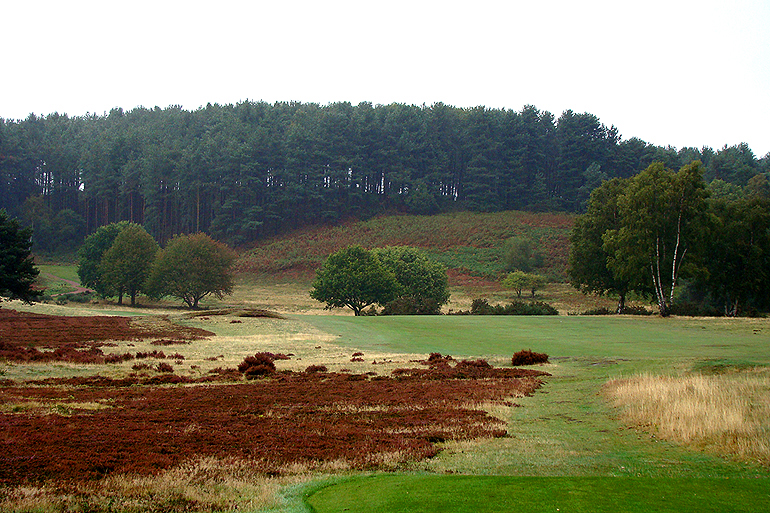
As seen from the tee, the dogleg left second is the favorite hole of many members.
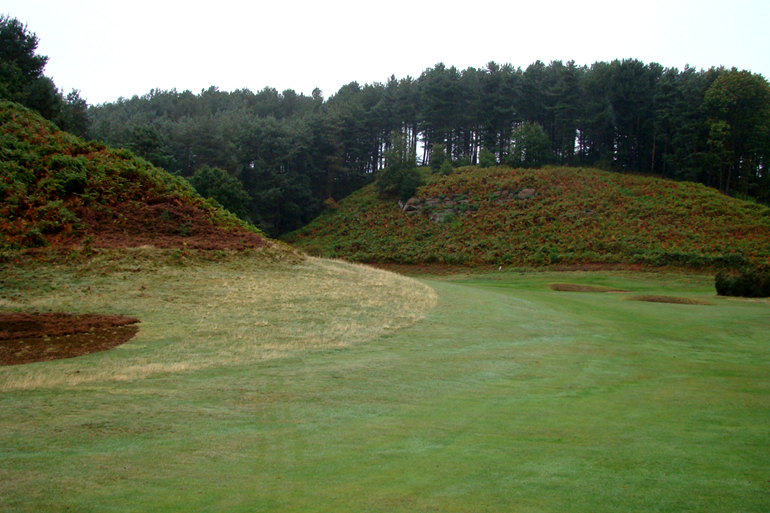
A round at Notts is played in the countryside, well removed from any outside disturbances other than the clubhouse. One benefit of such a setting is the diverse and handsome backdrops to its greens.
Third hole, 545 yards; The sleeper of the course, this short par five heads back to the clubhouse. From the elevated tee, the hole appears broad and encourages the big hitter to open his shoulders. The fun begins when the player is at that do-I-or-don’t-I spot for his second. Many a player who is undecided will try to compromise and play short-right of the green, wisely away from the entrance drive (which is not out of bounds) and bunkers on the left, he thinks. His only concerns are carrying the bunker some 65 yards short of the green and the right rough. However, he will soon realize he has been played the fool, for he now faces a short pitch over (or through) the slightest of swales to the right of the green and a pitch to the green from an awkward angle. He will now wish he had laid up short of the two left bunkers, from where he would have a longer but more straightforward approach.
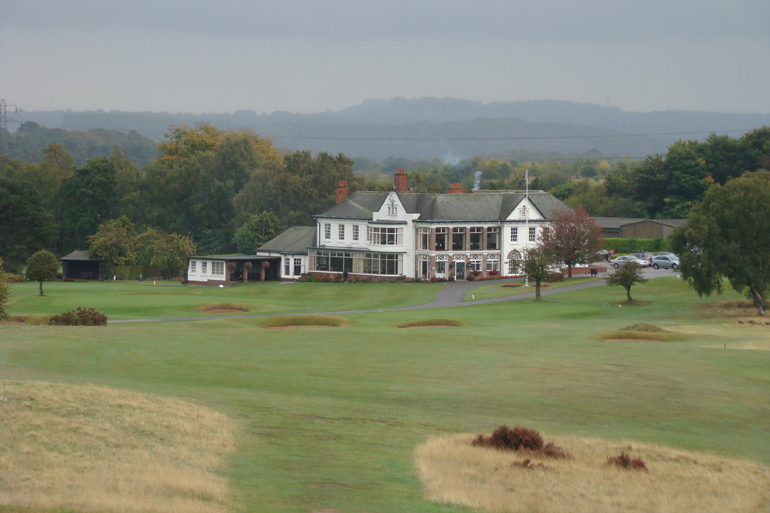
A clever hole, Williamson did well in that his three holes west of the entrance drive tie seamlessly into the rest of the course.
Fourth hole, 455 yards; Played away from the clubhouse, this was the first hole in Park’s routing. Of the five longest par fours on the course, four feature distinctly uphill tee shots with the forward progress of the tee ball often deadened by the hillside. Coupled with approach shots that are also uphill, holes like the second, fourth, and fifteenth play even longer than the card suggests.
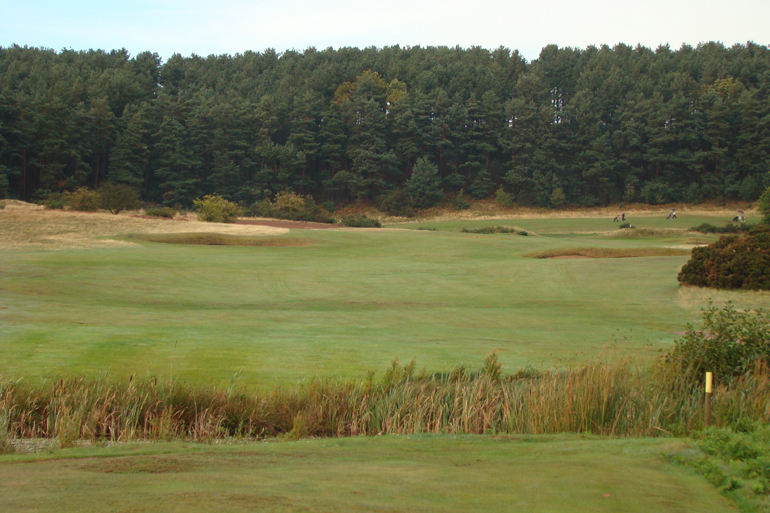
The short right and long left bunkers need to be avoided to have any hope of reaching the fourth green in two shots.
Sixth hole, 580 yards; When Park designed the course, this playing corridor housed a par four followed by a par three situated near today’s green site. Williamson converted the two holes into the three shotter that it is today and utilized the rolling topography to perfection. The ideal tee ball carries the crest of the hill and enjoys a huge kick forward, hopefully bringing the green within reach in two.
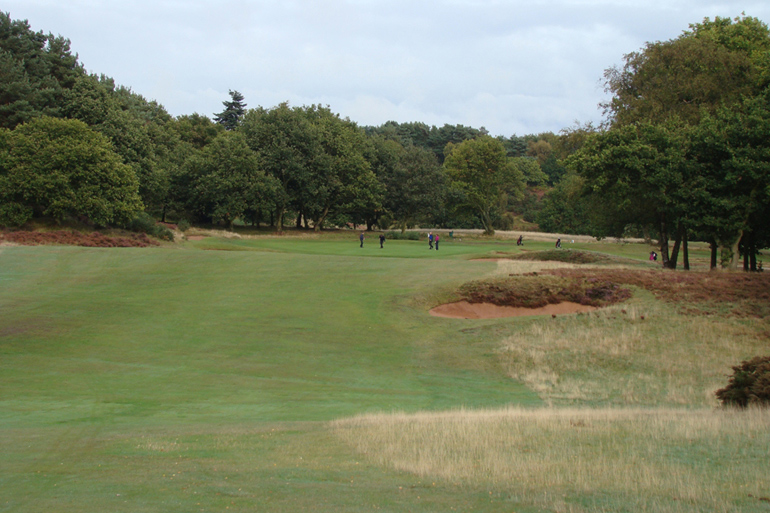
Once over the crest of the hill, the golfer is left with this attractive scene. Not unlike the eighteenth at Merion, the tiger hopes to hit some sort of a long low shot from the downslope and have it run onto the green.
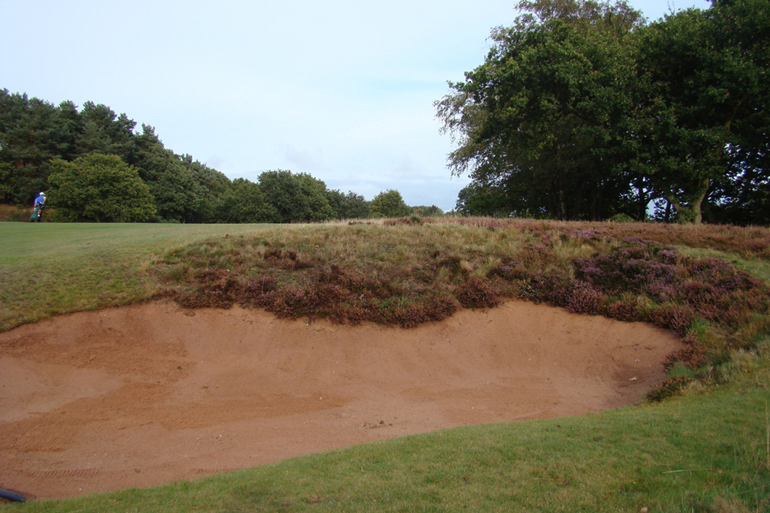
Cut into the hillside 120 yards from the green, this deep bunker is quite hazardous yet very appealing.
Eighth hole, 410 yards; The site of the famous ‘Holy Well,’ from whence Hollinwell derives its name and a sure sign that this isn’t ‘just another course.’ After the intimidating drive across the water and between the trees, the player should be sure to go down into the ‘well,’ take the metal cup fixed to a chain and sample the water himself. The approach is also quite inviting, with the left-to-right slope of the green.
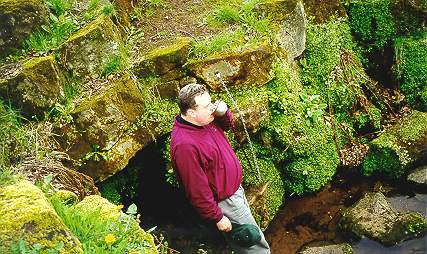
Drinking from the ‘Holy Well’ on the eighth.
Tenth hole, 415 yards; After holing out at the turn, the golfer walks through a row of trees to reach the tenth tee. From there, he looks out to a fairway with more abrupt movement than what he has seen previously. Indeed, he won’t see his tee ball land and the next five holes take the golfer on a grand counterclockwise loop, covering the most rambunctious terrain on the property. So starts one of the finest nine hole stretches in golf, inland or otherwise, as the golfer will be challenged to play a variety of herioc and creative shots.
Twelfth hole, 475 yards; The club best described this hole in its centenary pamphlet: ‘The worst or the best hole on the course is perhaps the 12th – according to the wind. Wind against – a great hole; wind behind – well, we cannot have it both ways.’ The hole plays along a high ridge and, approximately 170 yards from the green, the fairway drops off and to the left sharply, leaving the player who drives it there an awkward blind shot from a sloping stance. Yet, from around the 185 yard mark, the approach is one of the most fun shots on the course with the player using the high ground to the right of the green as a way to bank his approach onto the putting surface.
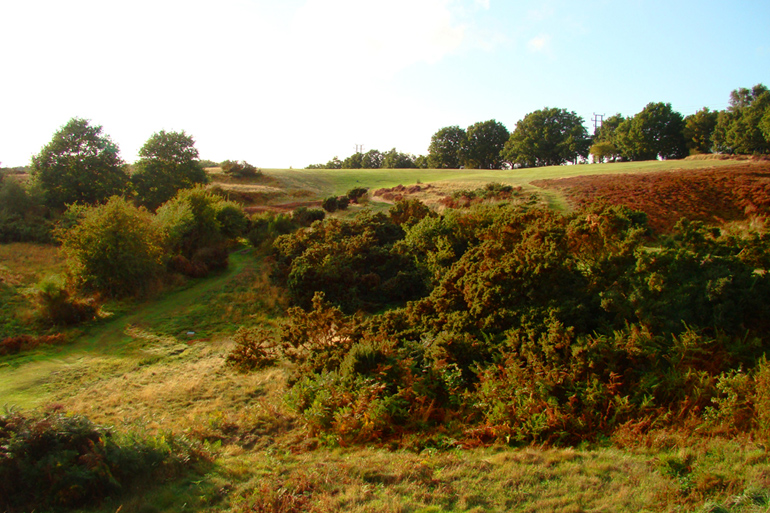
A thrilling forced carry over a chasm is required off the twelfth tee.
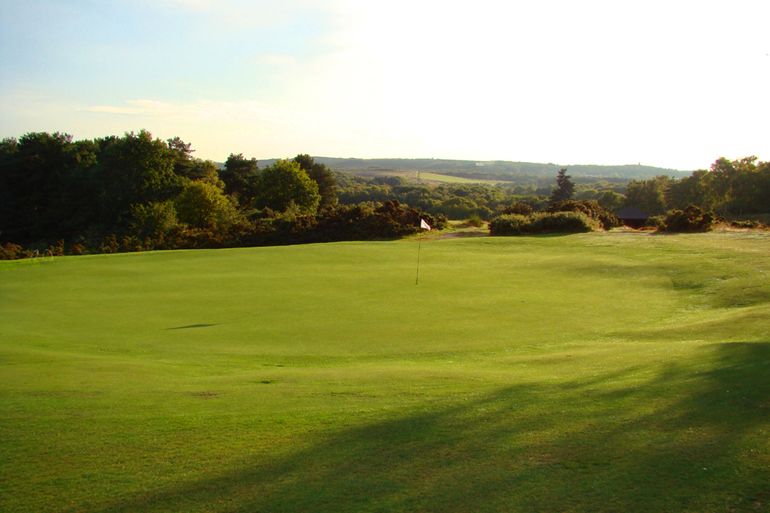
As seen across the twelfth green, the appeal of the English countryside never wanes.
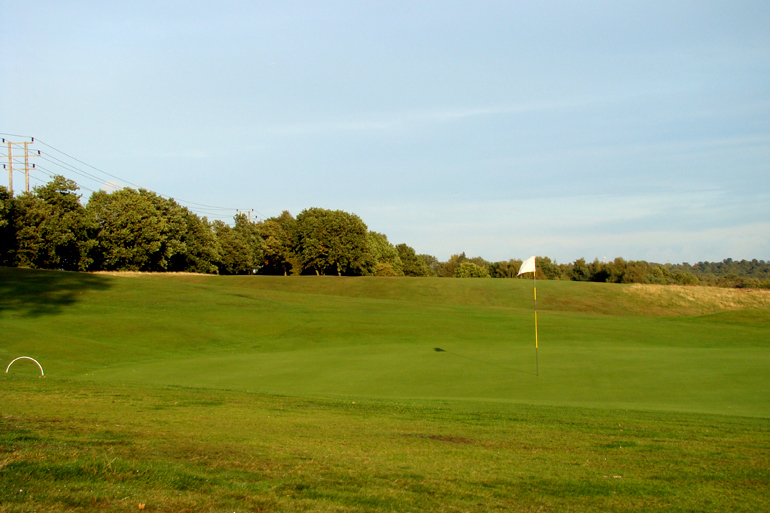
This view from behind the green shows how the golfer can use the slope right of the green to feed approach shots onto the putting surface.
Thirteenth hole, 240 yards; Notts is best known for this dramatic, downhill par three, which surely rivals the thirteenth at The Addington as the best long one shotter in inland British golf. Justly famous, this hole owes its creation to Williamson. The son of the station master at Bulwell Forest, Tom started caddying at age seven at the original Burwell site for Notts in the late 1880s. It says a lot about both Notts and Williamson that each found the others company satisfactory for over half a century! Since the distance on the thirteenth is quite taxing, especially exposed to the wind, Williamson gave the player enough room short and right of the green. However, this ‘safety’ zone cannot be believed until after several rounds as that area is largely hidden from the tee, partly by trees and partly by gorse. In difficult conditions, the player who is playing conservatively, therefore, will have to fire his tee shot off toward what looks to be most unfriendly country. Much more than just a pretty hole.

After a morning rain, this fall day gave way to brilliant late afternoon sunshine. At such moments, there a few places in world golf more enticing than the elevated thirteenth tee at Notts.
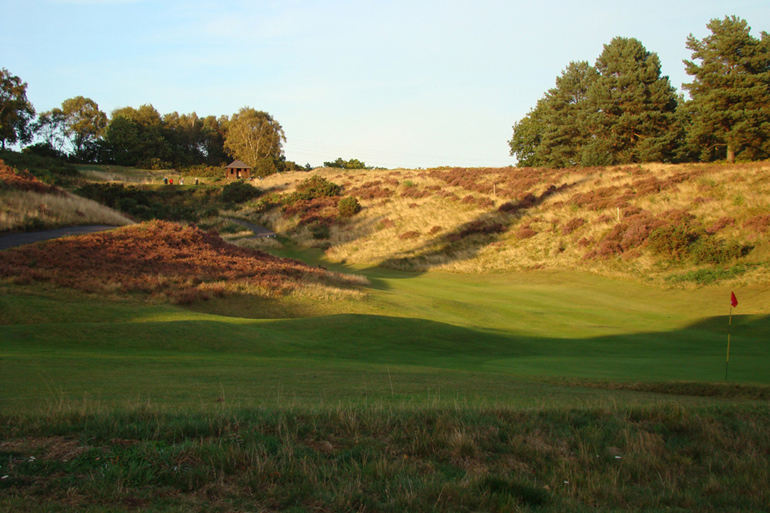
Looking back up from the green to the tee, the golfer gains an appreciation for the hole’s forty foot drop from tee to green.
Fifteenth hole, 440 yards; The favorite hole of some, this brute would be at home at Royal County Down. The narrow green with its 17 yard wide entrance is cruelly one of the smallest on the course and is set against and surrounded by what looks suspiciously like gorse-covered sand dunes. In fact, the player expects that he would catch a glimpse of the sea if he scaled them, only to be reminded by his friend that they are about as far removed from the sea as any spot in England.
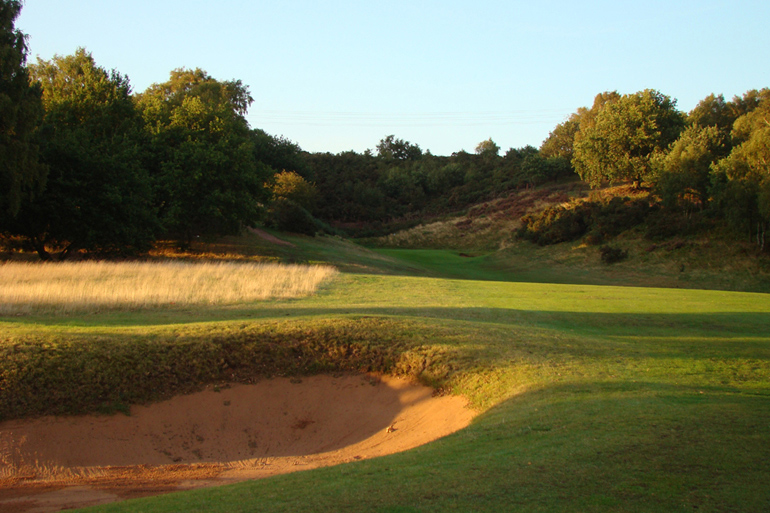
As seen 180 yards from the green, the golfer is asked to fit his approach into a none too big green located between two dunes.

Nestled in its own amphitheatre, the only smart place to miss the approach is short.
Sixteenth hole, 355 yards; From another elevated and exposed tee, the player plays down and (perhaps) to the right. This can be a fearsome proposition into the wind as there is nearly a 200 yard carry to the fairway. The green is quite wide but shallow (20 yards) and is perched atop a fearsome bunker. (There is also a wall of gorse behind the green that provides for more than just scenery – have you ever thinned a wedge from the fairway?) The front left of the green features the most slope of any putting surface on the course, befitting a hole of this length. The hole’s beauty lies in how each golfer is free to determine for himself the best way to play it.
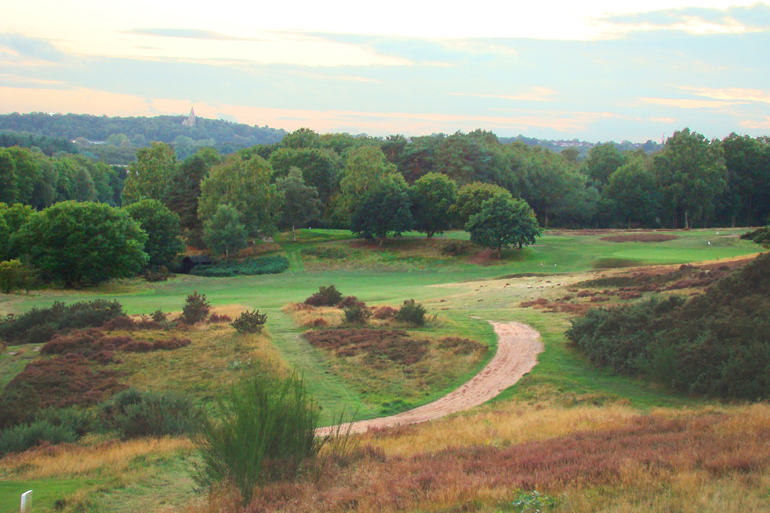
Perhaps the most interesting tee shot of the day occurs at the shortest par four. Two reasonable players could aim nearly 100 yards apart, one playing a driver directly toward the green while the other plays a spoon well left for the sake of enjoying a full wedge for his approach.
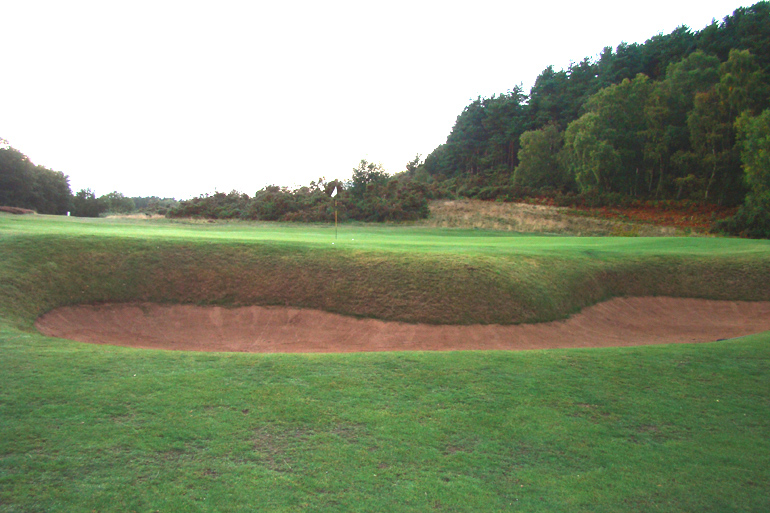
A forty yard long bunker walls off the entire front of the sixteenth green. Driving the ball into the bunker is a satisfactory outcome. However, being left with a forced carry in the mid distance wedge range of 50 to 70 yards is not the sort of fiddly shot that produces many birdies.
Eighteenth hole, 460 yards; Though many of the par fours play gradually up some sort of slope, both the sixteenth and eighteenth feature intoxicatingly attractive downhill views and tee shots. The clubhouse with its chimneys and warm glow emanating from within makes for an attractive backdrop.

The eighteenth requires stout hitting as it tumbles downhill toward the inviting clubhouse.
Two characteristics that Notts possesses that some other inland gems do not are length and difficulty. While such factors are not prerequisites for top courses, having them has never hurt a course. The inland courses of England seem to fall into two groups – the courses near London and the few top-notch ones that are scattered throughout the country (e.g., Woodhall Spa and Ganton). Notts has advantages over both. It possesses the length that several of the top London courses lack; it finishes well, unlike Woodhall Spa; and it has the variety that some of the courses, such as Ganton, lack. Even though it has twelve par fours, the variety in length, topography, shape, setting and pacing of the two-shotters at Notts holds the player’s interest so that he would never complain ‘Not another par four!’ People should beat a path to this course – it has it all.
The End



![Minchinhampton (Old) [2016]](https://golfclubatlas.com/wp-content/uploads/2018/09/Minchinhampton-500x383.jpg)
![St. Enodoc (Church) [2017]](https://golfclubatlas.com/wp-content/uploads/2017/11/St.-Enodoc-500x383.jpg)
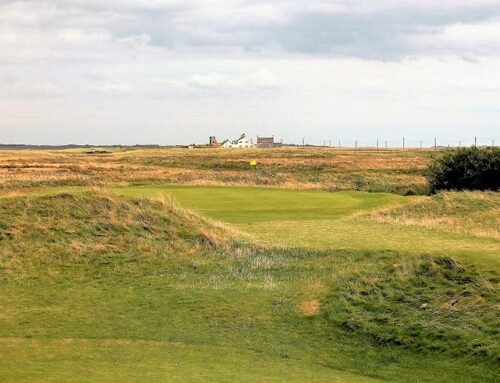
![Sunningdale (Old) [2014]](https://golfclubatlas.com/wp-content/uploads/2017/11/Sunningdale-Old-Course-500x383.jpg)
